Xilei Zhao
Where You Go is Who You Are: Behavioral Theory-Guided LLMs for Inverse Reinforcement Learning
May 22, 2025Abstract:Big trajectory data hold great promise for human mobility analysis, but their utility is often constrained by the absence of critical traveler attributes, particularly sociodemographic information. While prior studies have explored predicting such attributes from mobility patterns, they often overlooked underlying cognitive mechanisms and exhibited low predictive accuracy. This study introduces SILIC, short for Sociodemographic Inference with LLM-guided Inverse Reinforcement Learning (IRL) and Cognitive Chain Reasoning (CCR), a theoretically grounded framework that leverages LLMs to infer sociodemographic attributes from observed mobility patterns by capturing latent behavioral intentions and reasoning through psychological constructs. Particularly, our approach explicitly follows the Theory of Planned Behavior (TPB), a foundational behavioral framework in transportation research, to model individuals' latent cognitive processes underlying travel decision-making. The LLMs further provide heuristic guidance to improve IRL reward function initialization and update by addressing its ill-posedness and optimization challenges arising from the vast and unstructured reward space. Evaluated in the 2017 Puget Sound Regional Council Household Travel Survey, our method substantially outperforms state-of-the-art baselines and shows great promise for enriching big trajectory data to support more behaviorally grounded applications in transportation planning and beyond.
From Perceptions to Decisions: Wildfire Evacuation Decision Prediction with Behavioral Theory-informed LLMs
Feb 24, 2025Abstract:Evacuation decision prediction is critical for efficient and effective wildfire response by helping emergency management anticipate traffic congestion and bottlenecks, allocate resources, and minimize negative impacts. Traditional statistical methods for evacuation decision prediction fail to capture the complex and diverse behavioral logic of different individuals. In this work, for the first time, we introduce FLARE, short for facilitating LLM for advanced reasoning on wildfire evacuation decision prediction, a Large Language Model (LLM)-based framework that integrates behavioral theories and models to streamline the Chain-of-Thought (CoT) reasoning and subsequently integrate with memory-based Reinforcement Learning (RL) module to provide accurate evacuation decision prediction and understanding. Our proposed method addresses the limitations of using existing LLMs for evacuation behavioral predictions, such as limited survey data, mismatching with behavioral theory, conflicting individual preferences, implicit and complex mental states, and intractable mental state-behavior mapping. Experiments on three post-wildfire survey datasets show an average of 20.47% performance improvement over traditional theory-informed behavioral models, with strong cross-event generalizability. Our complete code is publicly available at https://github.com/SusuXu-s-Lab/FLARE
Post-hurricane building damage assessment using street-view imagery and structured data: A multi-modal deep learning approach
Apr 11, 2024Abstract:Accurately assessing building damage is critical for disaster response and recovery. However, many existing models for detecting building damage have poor prediction accuracy due to their limited capabilities of identifying detailed, comprehensive structural and/or non-structural damage from the street-view image. Additionally, these models mainly rely on the imagery data for damage classification, failing to account for other critical information, such as wind speed, building characteristics, evacuation zones, and distance of the building to the hurricane track. To address these limitations, in this study, we propose a novel multi-modal (i.e., imagery and structured data) approach for post-hurricane building damage classification, named the Multi-Modal Swin Transformer (MMST). We empirically train and evaluate the proposed MMST using data collected from the 2022 Hurricane Ian in Florida, USA. Results show that MMST outperforms all selected state-of-the-art benchmark models and can achieve an accuracy of 92.67%, which are 7.71% improvement in accuracy compared to Visual Geometry Group 16 (VGG-16). In addition to the street-view imagery data, building value, building age, and wind speed are the most important predictors for damage level classification. The proposed MMST can be deployed to assist in rapid damage assessment and guide reconnaissance efforts in future hurricanes.
Causality-informed Rapid Post-hurricane Building Damage Detection in Large Scale from InSAR Imagery
Oct 02, 2023



Abstract:Timely and accurate assessment of hurricane-induced building damage is crucial for effective post-hurricane response and recovery efforts. Recently, remote sensing technologies provide large-scale optical or Interferometric Synthetic Aperture Radar (InSAR) imagery data immediately after a disastrous event, which can be readily used to conduct rapid building damage assessment. Compared to optical satellite imageries, the Synthetic Aperture Radar can penetrate cloud cover and provide more complete spatial coverage of damaged zones in various weather conditions. However, these InSAR imageries often contain highly noisy and mixed signals induced by co-occurring or co-located building damage, flood, flood/wind-induced vegetation changes, as well as anthropogenic activities, making it challenging to extract accurate building damage information. In this paper, we introduced an approach for rapid post-hurricane building damage detection from InSAR imagery. This approach encoded complex causal dependencies among wind, flood, building damage, and InSAR imagery using a holistic causal Bayesian network. Based on the causal Bayesian network, we further jointly inferred the large-scale unobserved building damage by fusing the information from InSAR imagery with prior physical models of flood and wind, without the need for ground truth labels. Furthermore, we validated our estimation results in a real-world devastating hurricane -- the 2022 Hurricane Ian. We gathered and annotated building damage ground truth data in Lee County, Florida, and compared the introduced method's estimation results with the ground truth and benchmarked it against state-of-the-art models to assess the effectiveness of our proposed method. Results show that our method achieves rapid and accurate detection of building damage, with significantly reduced processing time compared to traditional manual inspection methods.
ICN: Interactive Convolutional Network for Forecasting Travel Demand of Shared Micromobility
Jun 24, 2023Abstract:Accurate shared micromobility demand predictions are essential for transportation planning and management. Although deep learning models provide powerful tools to deal with demand prediction problems, studies on forecasting highly-accurate spatiotemporal shared micromobility demand are still lacking. This paper proposes a deep learning model named Interactive Convolutional Network (ICN) to forecast spatiotemporal travel demand for shared micromobility. The proposed model develops a novel channel dilation method by utilizing multi-dimensional spatial information (i.e., demographics, functionality, and transportation supply) based on travel behavior knowledge for building the deep learning model. We use the convolution operation to process the dilated tensor to simultaneously capture temporal and spatial dependencies. Based on a binary-tree-structured architecture and interactive convolution, the ICN model extracts features at different temporal resolutions, and then generates predictions using a fully-connected layer. The proposed model is evaluated for two real-world case studies in Chicago, IL, and Austin, TX. The results show that the ICN model significantly outperforms all the selected benchmark models. The model predictions can help the micromobility operators develop optimal vehicle rebalancing schemes and guide cities to better manage the shared micromobility system.
Situational-Aware Multi-Graph Convolutional Recurrent Network (SA-MGCRN) for Travel Demand Forecasting During Wildfires
Apr 13, 2023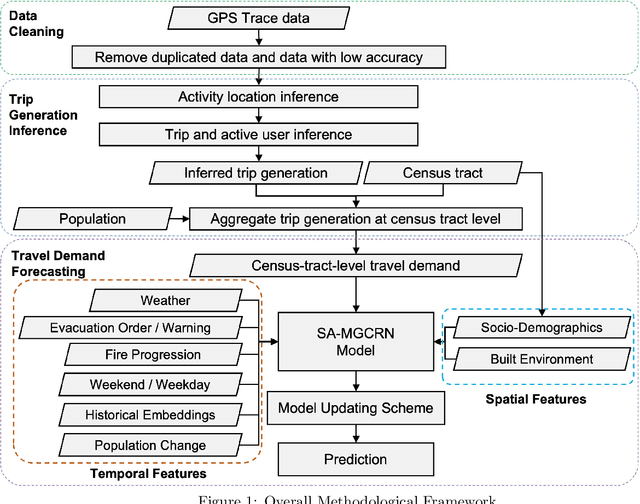
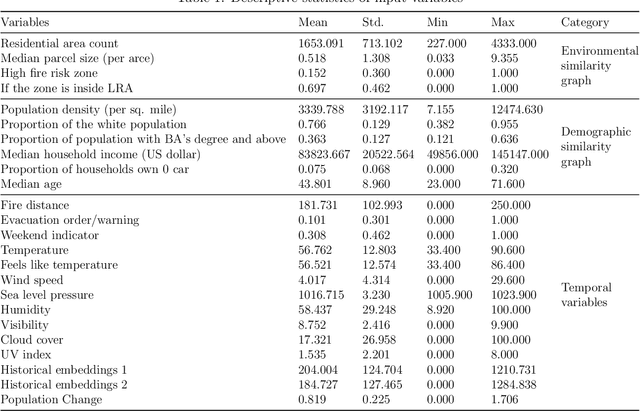
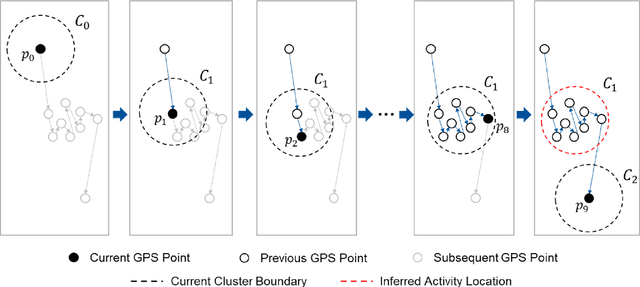
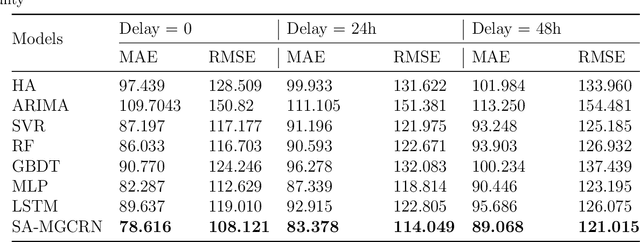
Abstract:Real-time forecasting of travel demand during wildfire evacuations is crucial for emergency managers and transportation planners to make timely and better-informed decisions. However, few studies focus on accurate travel demand forecasting in large-scale emergency evacuations. Therefore, this study develops and tests a new methodological framework for modeling trip generation in wildfire evacuations by using (a) large-scale GPS data generated by mobile devices and (b) state-of-the-art AI technologies. The proposed methodology aims at forecasting evacuation trips and other types of trips. Based on the travel demand inferred from the GPS data, we develop a new deep learning model, i.e., Situational-Aware Multi-Graph Convolutional Recurrent Network (SA-MGCRN), along with a model updating scheme to achieve real-time forecasting of travel demand during wildfire evacuations. The proposed methodological framework is tested in this study for a real-world case study: the 2019 Kincade Fire in Sonoma County, CA. The results show that SA-MGCRN significantly outperforms all the selected state-of-the-art benchmarks in terms of prediction performance. Our finding suggests that the most important model components of SA-MGCRN are evacuation order/warning information, proximity to fire, and population change, which are consistent with behavioral theories and empirical findings.
Predicting Hurricane Evacuation Decisions with Interpretable Machine Learning Models
Mar 12, 2023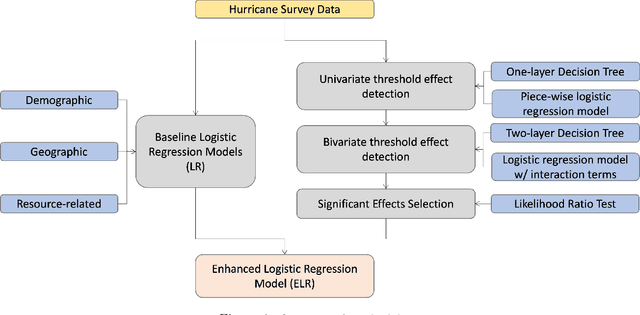
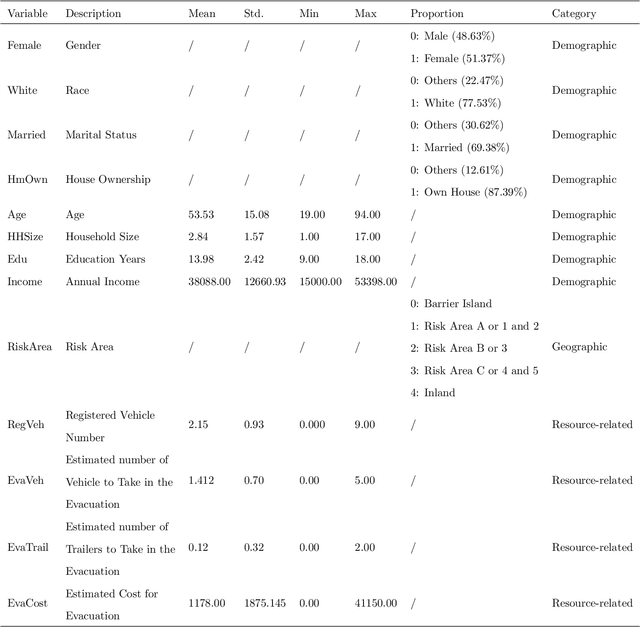
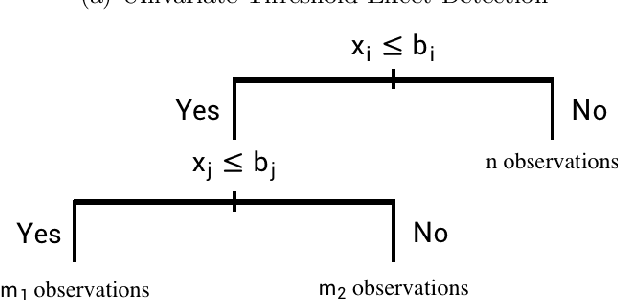

Abstract:The aggravating effects of climate change and the growing population in hurricane-prone areas escalate the challenges in large-scale hurricane evacuations. While hurricane preparedness and response strategies vastly rely on the accuracy and timeliness of the predicted households' evacuation decisions, current studies featuring psychological-driven linear models leave some significant limitations in practice. Hence, the present study proposes a new methodology for predicting households' evacuation decisions constructed by easily accessible demographic and resource-related predictors compared to current models with a high reliance on psychological factors. Meanwhile, an enhanced logistic regression (ELR) model that could automatically account for nonlinearities (i.e., univariate and bivariate threshold effects) by an interpretable machine learning approach is developed to secure the accuracy of the results. Specifically, low-depth decision trees are selected for nonlinearity detection to identify the critical thresholds, build a transparent model structure, and solidify the robustness. Then, an empirical dataset collected after Hurricanes Katrina and Rita is hired to examine the practicability of the new methodology. The results indicate that the enhanced logistic regression (ELR) model has the most convincing performance in explaining the variation of the households' evacuation decision in model fit and prediction capability compared to previous linear models. It suggests that the proposed methodology could provide a new tool and framework for the emergency management authorities to improve the estimation of evacuation traffic demands in a timely and accurate manner.
Enhancing Fairness in AI-based Travel Demand Forecasting Models
Mar 03, 2023Abstract:Artificial Intelligence (AI) and machine learning have been increasingly adopted for forecasting real-time travel demand. These AI-based travel demand forecasting models, though generate highly-accurate predictions, may produce prediction biases and thus raise fairness issues. Using such models for decision-making, we may develop transportation policies that could exacerbate social inequalities. However, limited studies have been focused on addressing the fairness issues of AI-based travel demand forecasting models. Therefore, in this study, we propose a novel methodology to develop fairness-aware travel demand forecasting models, which are highly accurate and fair. Specifically, we add a fairness regularization term, i.e., the correlation between prediction accuracy and the protected attribute such as race or income, into the loss function of the travel demand forecasting model. We include an interactive weight coefficient to both accuracy loss term and fairness loss term. The travel demand forecasting models can thus simultaneously account for prediction accuracy and fairness. An empirical analysis is conducted using real-world ridesourcing-trip data in Chicago. Results show that our proposed methodology effectively addresses the accuracy-fairness trade-off. It can significantly enhance fairness for multiple protected attributes (i.e., race, education, age and income) by only sacrificing a small accuracy drop. This study provides transportation professionals a new type of decision-support tool to achieve fair and accurate travel demand forecasting.
Examining spatial heterogeneity of ridesourcing demand determinants with explainable machine learning
Sep 16, 2022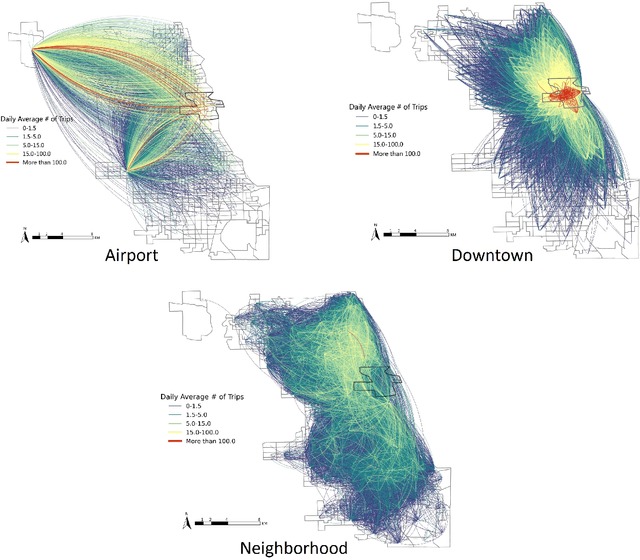

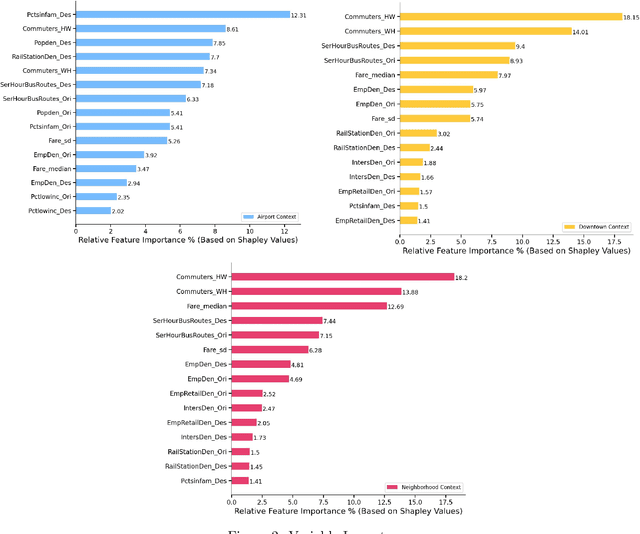

Abstract:The growing significance of ridesourcing services in recent years suggests a need to examine the key determinants of ridesourcing demand. However, little is known regarding the nonlinear effects and spatial heterogeneity of ridesourcing demand determinants. This study applies an explainable-machine-learning-based analytical framework to identify the key factors that shape ridesourcing demand and to explore their nonlinear associations across various spatial contexts (airport, downtown, and neighborhood). We use the ridesourcing-trip data in Chicago for empirical analysis. The results reveal that the importance of built environment varies across spatial contexts, and it collectively contributes the largest importance in predicting ridesourcing demand for airport trips. Additionally, the nonlinear effects of built environment on ridesourcing demand show strong spatial variations. Ridesourcing demand is usually most responsive to the built environment changes for downtown trips, followed by neighborhood trips and airport trips. These findings offer transportation professionals nuanced insights for managing ridesourcing services.
A Clustering-aided Ensemble Method for Predicting Ridesourcing Demand in Chicago
Sep 08, 2021Abstract:Accurately forecasting ridesourcing demand is important for effective transportation planning and policy-making. With the rise of Artificial Intelligence (AI), researchers have started to utilize machine learning models to forecast travel demand, which, in many cases, can produce higher prediction accuracy than statistical models. However, most existing machine-learning studies used a global model to predict the demand and ignored the influence of spatial heterogeneity (i.e., the spatial variations in the impacts of explanatory variables). Spatial heterogeneity can drive the parameter estimations varying over space; failing to consider the spatial variations may limit the model's prediction performance. To account for spatial heterogeneity, this study proposes a Clustering-aided Ensemble Method (CEM) to forecast the zone-to-zone (census-tract-to-census-tract) travel demand for ridesourcing services. Specifically, we develop a clustering framework to split the origin-destination pairs into different clusters and ensemble the cluster-specific machine learning models for prediction. We implement and test the proposed methodology by using the ridesourcing-trip data in Chicago. The results show that, with a more transparent and flexible model structure, the CEM significantly improves the prediction accuracy than the benchmark models (i.e., global machine-learning and statistical models directly trained on all observations). This study offers transportation researchers and practitioners a new methodology of travel demand forecasting, especially for new travel modes like ridesourcing and micromobility.
 Add to Chrome
Add to Chrome Add to Firefox
Add to Firefox Add to Edge
Add to Edge